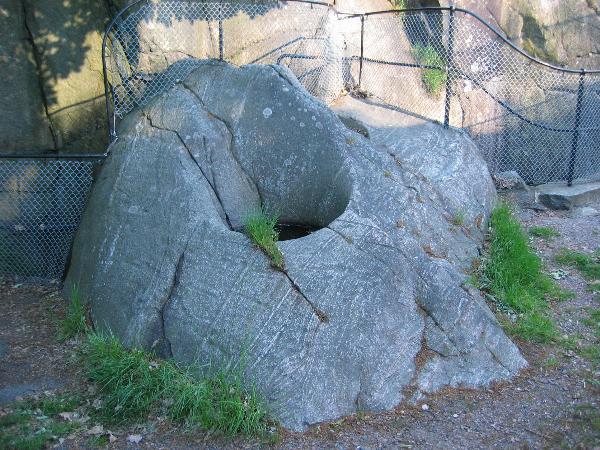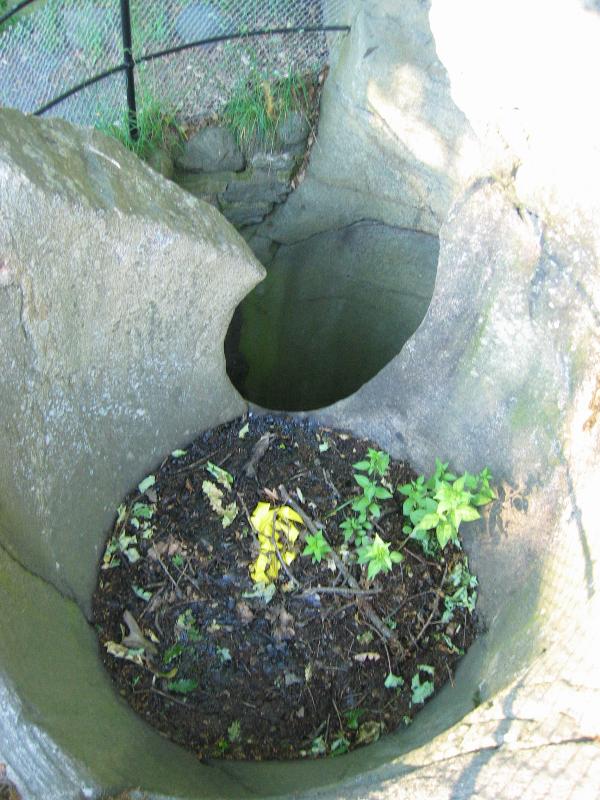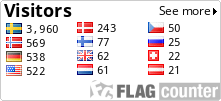You can log this cache as found, but at the same time you have to send me an e-mail and answer the questions on this cache-page. I will send you a replay.
Du får lov att logga hittad direkt på denna earth cache, men samtidigt måste du skicka mig e-post med de rätta svaren. Jag skickar dig ett svar inom några dagar.
The Giant Kettles of Jakobsdal
This is an earthcache so there is no box on the site. To log this cache, you must answer a number of questions; see further down on this page.

Almost in the middle of Gothenburg, a few steps from Liseberg, is a memory from our last ice age. Giant Potholes (Kettles) was formed by rocks and gravel that were in motion through the water swirls in the rushing water, so-called runners. These have been slowly but surely created and formed "pots". The biggest potholes formed during the Ice Age, but there are also more recent pots formed at waterfalls, or on the coast. The formation process starts as the mountain heel increases stream velocity and water dissolved gas forms bubbles. Current velocity decreases contrast below mountains heel and gas bubbles dissolved. Gas bubbles then dissolved near rocks gives rice to cavitations. In the small pit that formed gravel and stones start to whorl. Down in the bottom of the giant kettle you can sometimes find the so-called runner, remains of the stone that formed the kettle.

The kettles in Jacobsdal are located at the mountain heel at a location that was a stream of water during the end of the last ice age.

Kettles can also become much larger than the ones in Jakobsdal and even form lakes!
“Kettle: also called Kettle Hole, in geology, depression in a glacial outwash drift made by the melting of a detached mass of glacial ice that became wholly or partly buried. The occurrence of these stranded ice masses is thought to be the result of gradual accumulation of outwash atop the irregular glacier terminus. Kettles may range in size from 5 m (15 feet) to 13 km (8 miles) in diameter and up to 45 m in depth. When filled with water they are called kettle lakes. Most kettles are circular in shape because melting blocks of ice tend to become rounded; distorted or branching depressions may result from extremely irregular ice masses.
Two types of kettles are recognized: a depression formed from a partially buried ice mass by the sliding of unsupported sediment into the space left by the ice and a depression formed from a completely buried ice mass by the collapse of overlying sediment. By either process, small kettles may be formed from ice blocks that were not left as the glacier retreated but rather were later floated into place by shallow meltwater streams. Kettles may occur singly or in groups; when large numbers are found together, the terrain appears as mounds and basins and is called kettle and kame topography.” ("kettle." Encyclopædia Britannica. 2009. Encyclopædia Britannica Online. 2 June 2009)
The giant Kettles of Jakobsdal formed at the end of our last ice age and is known as glacial pothole. This is one of the most impressive glacial remnants we have in the city of Göteborg.
Many legends exists around giant kettles. In the case of Jakobdals Giant Kettles the tradition says that giants lived on this place when the earth was created and that the "kettle" were the giants kitchen! It is said that these pots were the property of Valåsjätten in Örgryte, he was also responsible for the large gravel ridges in the area (ör in Örgryte means gravel), he emptied his pockets filled with sand!
More down to earth events unfolded at the giant kettles in the 1800s. Then took chemist Jakob Cavallin owner of the farm Jakobsdal, hence the name (formerly known as the farm Örgryte backbone). James owned the pharmacy Kronan in Gothenburg and was the major importer of medicinal plants. He established a laboratory at Jakobsdal. Some of the experiments he conducted with his students at the pothole. It is said that even he climbed down into the kettle to eat his lunch there! The latter is probably more of a tale!
To log, you must:
And send me by e-mail the answer to the following questions:
How many giant kettles are there on site?
What is our last ice age called?
When began and ended our last ice age?
When it is estimated that Gothenburg was free of ice?
Optional: Take a photo of yourself and your GPS and one of the giant kettles.

Jakobsdals jättegrytor
Detta är en earthcache därmed finns ingen låda på platsen. För att få logga denna cache måste du svara på ett antal frågor, se längre ned på denna sida.
Nästan mitt i Göteborg, ett kort stycke från Liseberg, finns ett minne från vår senaste istid. Jättegrytor har bildats av stenar och grus som hållits i rörelse genom vattenvirvlar i forsande vatten, så kallade löpare. Dessa har sakta men säkert gröpt ur berget och bildat ”grytor”. De största jättegrytorna bildades under istiden, men det finns även mer sentida grytor som bildats vid vattenfall, eller vid kusten.
”jättegryta, hål i fast berg eller lösa block, bildat genom naturliga processer. Grytorna är runda till ovala i tvärsnitt och kan bli flera meter breda och djupa. Man kan urskilja fyra olika slag. Älvgrytor bildas i vattenfall eller forsar. Glaciala jättegrytor har bildats under inlandsisen med hjälp av starkt strömmande smältvatten som satt stenar i rotation. Strandgrytor har skulpterats ut av havsvågor med hjälp av strandklapper. Vittringsgrytor är vanliga i graniter och sandstenar i hela världen. Vittringsgrytor finns i s. Sverige. De bildades där under krittiden och finns ofta i anslutning till fast anstående krita.” (NE)
Jättegrytorna vid Jakobsdal bildades under slutet av vår senaste istid och är så kallade glaciala jättegrytor. Detta är en av de mest imponerande istidslämningar vi har inom Göteborgs stad.
Jättegrytor är sägenomspunna. Det finns nästan alltid en tradition kring platsen. I fallet med Jakobdals jättegrytor sägs det att jättar bodde på denna plats redan när jorden skapades och att ”grytorna” tillhörde jättarnas köksutrustning! Det sägs att dessa grytor tillhörde Valåsjätten i Örgryte, han var även ansvarig för de stora grusåsarna i området (ör i Örgryte betyder grus), han tömde nämligen sina fickor som var fyllda med sand. Tänk så enkla och naturliga förklaringar det finns till fenomenen i vår natur!
Mer jordnära händelser utspelade sig vid jättegrytorna under 1800-talet. Då ägde apotekaren Jakob Cavallin gården Jakobsdal, därav namnet (tidigare kallades gården Örgryte stom). Jakob ägde apoteket Kronan inne i Göteborg och var stor importör av medicinalväxter. Han inrättade ett laboratorium på Jakobsdal. En del av experimenten utförde han tillsammans med sina elever vid Jättegrytorna. Det sägs att man även klättrade ned i grytorna för att äta sin matsäck där! Det senare är nog mer en skröna!
För att få logga måste du:
Samt skicka mig per e-post svaret på följande frågor:
Hur många jättegrytor finns det på platsen?
Vad kallas vår senaste istid?
När ungefär började och slutade vår senaste istid?
När räknar man med att Göteborgsområdet var fritt från is?
Frivilligt: Ta ett foto av dig själv och din GPS vid en av jättegrytorna.
